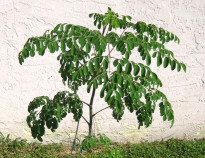Moringa Stenopetala is also known in Africa, as the Mother's Helper
tree, due to its ability to nourish infants, and increase the milk supply of nursing mothers.
Moringa Stenopetala leaves are shaped a bit differently than Moringa Oleifera's
but still have that same wonderful aroma and taste. The thumbnail photos to the right exemplify the tree's remarkable ability
to withstand cooler than normal temperatures.
These little guys of ours made a spectacular comeback!
"Hi! I'm Morey, the Moringa Oleifera
Seed!This page is about
Stan, so I don't have
anything to say here!"
Ah, the African Moringa tree! We grow it, we eat it, we sell it. Even though the Moringa Oleifera is the most commonly known variety of Moringa, it is not our personal favorite. Do we grow it? Absolutely! Do we eat it? Most certainly! Do we recommend it? Positively! Do
we sell it? We do! But, is it our favorite? No, but it WOULD be, if it weren't for Stenopetala.
The African Moringa tree is just a more unusual tree. Its leaves have a robust, hearty flavor, and the tree develops a REALLY interesting bulb-like trunk. That trunk stores a lot of water for the tree, in case of drought-like conditions. The seeds of the Moringa Stenopetala are quite distinctive, as they are a light tan, with a shape reminiscent of almonds, and they are generally larger than the Moringa Oleifera seeds, which are round and brown with tan "frilled" edges. See "Morey" and "Stan", our mascots, at the top and right of the page,
for a good example of the differences. Both Moringa, but very different.
The little thumbnail photos below, will enlarge, if you click on them. The ones on the left, show 2 seedlings that actually SURVIVED 28 - 40 degree Fahrenheit temperatures, during the 2010 winter, here in Florida. It was a rough winter, for those of us who are not used to having temperatures that low, at night. They looked like "sticks", but have budded out down their entire trunk, right to the ground. On the right, are photos of 2 week-old Moringa Stenopetala seedlings. They are just delightfully resilient plants, and when they are only a few weeks old, we harvest most of their leaves, and eat them.
Moringa Stenopetala seeds are a bit harder to obtain than Moringa Oleifera, but we usually have a good supply on hand. On occasion, we run out, but eventually get more.
If you prune your Moringa Stenopetala trees a lot, you will have to wait years, before they produce pods. If you simply let them grow, you should have flowers and pods within two years of planting them. They do not produce seeds as freely as the Moringa Oleifera trees do, but they also do not like to be pruned as often. You can still harvest the leaves, but leave some on the tree so that it will be encouraged to blossom and grow seed pods.
"Hi! My name is Stan.
This page is all about me, the African Moringa Stenopetala seed!"
"My seeds are very
valuable, for their
incredible ability
to purify water!
Not only are my seeds able to remove over 90%
of the impurities
in water, they have
also been found
to remove heavy
metals and
bacteria. Some scientists have
done experiments with my seeds,
and found that
they are able to remove bacteria, waterborne viruses, and purify the water so that it is pure enough to drink; even very polluted water from
the Nile River!"
MORINGA STENOPETALA
THE AFRICAN MORINGA TREE
< CLICK ON THE SMALL PHOTOS TO ENLARGE THEM >
I Love Moringa
the fast-growing, nutritious, delicious gift from God
This page was last updated: September 2, 2022
HOW TO:
More About --- Moringa
